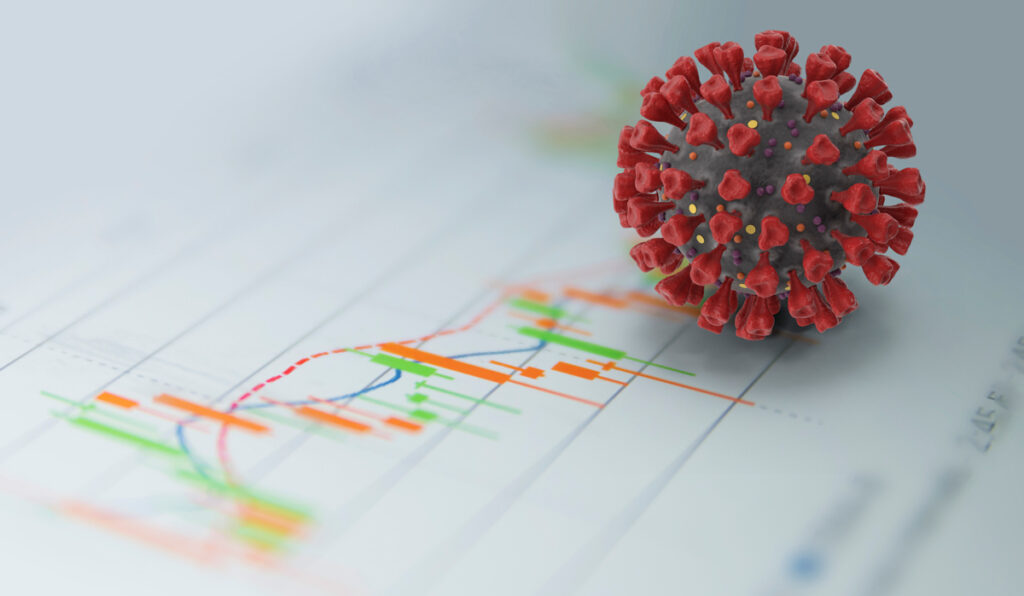Meet the man behind one of the most widely-read COVID-19 reports among U.S. healthcare supply chain leaders.

Mark Van Sumeren said three things prompted him to begin to dig into the data and analytics about COVID-19 case numbers.
First, he was restless. Like most working professionals in March 2020, he was sitting in his home office wondering when he was going to get back out on the road either for client business or other purposes. “I don’t sit still very well.”
Second, he was curious. “We look back at how little we knew about this virus last March, and how we probably still don’t know a lot, but we know a whole lot more.”
Finally, and perhaps the most important, Van Sumeren was frustrated. Much of the reporting and narratives weren’t being given a lot of insight, “and I think part of that is, unfortunately, we got caught up in a political year,” he said. “Everything was reported with a political lens on it. So it was either, ‘The sky is falling,’ or, ‘There is nothing to this.’ Now, we know that the truth was in the middle.”
Van Sumeren wanted to see if he could glean some insight from the mass of data that could better inform teams so that they could lead their organizations better, direct their people better, and live their lives a little bit better. Based off the industry’s response, he’s succeeded with the creation of his COVID-19 report.
JHC recently reached out to Mark Van Sumeren to discuss what prompted the creation of his widely read daily COVID-19 overviews and forecasts, as well as his thoughts on how the healthcare supply chain has handled the pandemic and what he sees for the industry going forward.
JHC: What goals did you have for the report?
Mark Van Sumeren: I didn’t set out to do it. I didn’t set out for it to become what it’s become.
It does require a lot of time. It’s probably three to five hours a day. What kept me going was feedback I got from people. There are a lot of people that I’ve had the pleasure of working with in this industry for 40 years. And to me, I had an opportunity to provide information that [my friends] found useful and that’s pretty rewarding right there.
There were all these wonderful sources of data … and being an engineer by training, I was curious about the data and if I could make my own insights or determination from it.
I started playing with the data for my own edification and found some things that weren’t being told through the popular reporting, because it required some insight and analytics that [most people] don’t have the time to do.
I was educating myself and I started sharing with a few friends and former colleagues and said, “Is this of any interest to you?”
Well, the response back universally was, “This is great, keep sending it. And by the way, here are seven other people I want you to send this to.”
JHC: How did you sort through all the noise to deliver actionable insights?
Van Sumeren: Early on – back in March and into April of last year – all eyes were on Italy, and Italy was on fire.
It was a disaster, and one of the insights I picked up early on is that the reports every day would be “How many more cases” and “How many more deaths?”
Well, the counts only go up, they never go down. So that’s not very practical, or it’s not actionable unless you know what direction it’s heading. So I started to look for, “Can I tell when it starts to turn? When the number of new cases will start to diminish, the number of hospitalizations will diminish.”
I was able to find that, without getting too engineering or technical, if you start to look at the derivative or the second derivative of the cases, I could predict when new cases would start to decline days or weeks ahead of time, because the rate of change would slow down.
JHC: What everybody really wants to know is, when do you think you’ll get to wrap up the report?
Van Sumeren: Well, as a self-confession, I’ve got all my models and spreadsheets where I pull the data together and I first set it up to run through May 15 of 2020. Obviously, we blew through that date pretty quickly.
I’ve got on my wall some metrics that I said, “I will be done with this when we hit all of these metrics.”
If new cases are on a downward slope and they reach a point that they’re lower than they have been since we started in March 2020 (when they were doubling every day) … if they drop below that and they’re declining, and the same thing holds true with hospitalizations, and if we get to a 60% vaccination rate, I will say I’m pretty confident that I can wrap this up.
If I had to stake a bet, I would say it’s going to be maybe just before – but probably a little bit after – Memorial Day that we will be at a good point.
I’m not suggesting that the virus will be done and over with, but I think we’ll be at a point where it’ll be contained and unless something unusual happens, it’ll be more like the annual flu type of thing in terms of its level of impact.
So that’s my bet right there.
JHC: How do you feel about the healthcare supply chain’s response to the pandemic?
Van Sumeren: When the demand for ventilators and gloves and protection equipment goes up by a factor of 10 or 20, or 50 – no one could have prepared for that.
So let’s dispense with the finger-pointing, but let’s learn from what we went through and ask, “How do we get better about this going forward?”
I sat in on a meeting of medical device operational directors this week, and one of the takeaways from that, hearing from the provider side of the community, is that the providers’ supply chain is now elevated in importance inside the four walls of the health system.
And that was long overdue.
To many, that’s great. To some people, that can be a little scary, but I think the value and role that supply chain plays has never been so obvious as it’s been over the last year.
JHC: Do you think that’s going to stick?
Van Sumeren: I do. As I said, I’ve spent the better part of my career advising senior management – I did a lot of operations of finance work and got engaged in the supply chain just before the middle of my career, if you will. But my 10 years as a partner with the E&Y I was advising CEOs, CFOs, COOs, and I was basically teaching them of the importance of supply chain.
Because back in the ‘90s, the early 2000s, it was not important and I got accused by one of my other partners of, “Why are you educating the client base? They won’t need us.”
So I said, “I’m educating so that they will need us.” Because an informed executive suite is going to be more demanding, but going to need more from the supply chain organization and really, that’s where I spent my time.
So I have great confidence that these senior leadership teams, now that they see the criticality of the supply chain, will not forget that lesson.
JHC: Do you have any predictions about how the landscape of the industry is going to change as a result of lessons learned?
Van Sumeren: I think there are some changes that are going to stay in place. [There’s the] idea of the nearshoring or onshoring, dual-source versus sole source as being a way of minimizing risk, but also I think we’re probably going to see higher utilization of certain things. Protective equipment, gloves, and things like that.
What this pandemic showed us is that we had gotten accustomed to operating within a rather narrow band of variability, and I think we’ve broken through those bands.
I don’t expect that the future will return us to that same narrow band, so we’re going to have to build in that flexibility to not simply reorder the amount that we reuse but start to think ahead.
We need to have better ways of syncing up inventories, or sharing, or better flexibility, resilience, if you will, in the supply chain to get it where it needs to be.
JHC: How were you able to forecast the trends of the pandemic so accurately? Are there any methods that might have application for supply chain leaders?
Van Sumeren: By spending enough time with the information, you could start to see patterns and get some insight to when the momentum was going to change. I think that has applicability to these supply chain leaders as they think about, “What are the triggers or the signals that something has changed, and therefore, demand is going to go up or down and I need to react. What are those triggers inside our organization or in the local community or even globally, that might start to indicate something has changed, and I need to prepare myself for it.”
The sourcing side of [supply chain] will be even more important going forward, but we under-invested in technology and the knowledge that we need to have about products, and location, and status, and that sort of thing and I think we got caught short by that under-investment.
We left ourselves with a lot of work to do now – not only to put it all back together, but now to learn the lessons that we’ve learned, and being able to make adjustments as we need.
To sign up for the report and access the full past archive for free, visit healthindustryadvisor.com/days.php.
About Mark Van Sumeren

Mark has 35 years of experience with strategy development and execution, business intelligence, industry insight and supply chains. He started out of undergraduate school working as an industrial engineer at what is now the Detroit Medical Center in the mid to late 1970s. He then went to work at Ernst and Young (then Ernst and Whinney) in its healthcare consulting practice, and spent 20 years with the company, working for the latter half of that time as a partner.
In the late ’90s, he helped start the company’s healthcare supply chain consulting practice, successfully growing the practice into a sizeable firm. He then joined Owens & Minor, where he spent 11 years as an officer with responsibility for strategy and business development.
Since going into “retirement” six years ago, he has continued to work with healthcare organizations in consulting roles, mostly working in longer-term relationships with a small group of organizations.
